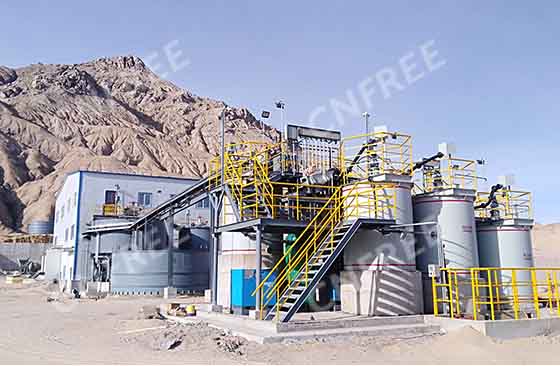2020-08-05 Views:3580
Warm Tip: If you want to know more information, like quotation, products, solutions, etc., please Click here ,and contact us online.

In gold cyanidation plant, although part of the cyanide wastewater has been returned for reuse, there are still some cyanide wastewater or cyanide residue discharged. Cyanide is highly toxic, so these cyanide wastewater must be treated professionally before discharging to avoid the environment pollution and damage to human and animal health. At present, the following are the commonly used cyanide wastewater treatment methods in gold cyanidation plants.
Alkaline chlorination is a method commonly used in various countries. This method requires adding chlorine oxidant highly-charged oxidation states in alkaline cyanide wastewater. The commonly used oxidants are ClO2, Cl2 (gas and liquid), bleach powder, sodium hypochlorite, calcium hypochlorite, chlorite and so on. In alkaline solutions, OCl- or chloride highly-charged oxidation are generally generated. The Cyanide is first oxidized to cyanate and further oxidized to carbon dioxide and nitrogen.
Inco method was developed by Inco Ltd. in 1982. It is mainly to add the mixture of SO2 and air into the cyanide wastewater, and control the pH value at 8~l0. And the cyanide in the wastewater was oxidized by the catalysis of bivalent copper ion.
H2O2 oxidizes cyanide to generate CNO- under the condition of pH 9.5 ~ 11, normal temperature and copper (Cu2+) ion as the catalyst. CNO- will be further hydrolyzed to produce NH4+ and CO32-. And the hydrolysis rate depends on the pH.
The oxidation ability of ozone is extremely strong, the electrode potential is 2.07mV, only second to fluorine. It can easily decompose the components that other oxidants cannot. The chemical reaction mechanism of ozone oxidation process is: ozone reacts with cyanide to produce cyanate, which hydrolyzes to produce nitrogen and carbonate.
Acidification method can process most of the solution with high cyanide concentration (60*10-6 + NaCN) discharged from factories. The concentration of free cyanide ion in solution processed can be reduced to 1*10-6.
Natural degradation method is a purification method that uses natural factors such as illumination to decompose cyanide. It includes the effects of cyanide volatilization, self-decomposition, oxidation, photochemical degradation, biodegradation, precipitation and adsorption, which is the result of a complex comprehensive action of physical chemistry, photochemistry and biochemistry.
The two-step precipitation method is a high-efficient closed-circuit full-circulation method developed for small and medium gold cyanidation plant with high concentration of SCN- wastewater, which realizes the “zero release” of wastewater. The two-step precipitation method is mainly to add catalyst and enough oxygen to the wastewater cyanide, and remove cyanide by the following reaction on the gold loaded carbon.
2Cu++2SCN-→Cu2(SCN)2↓(White)
Ca2++SO42-→CaSO4↓(White)
Pb2++SO42-→PbSO4↓(White)
H++CN-→HCN
The above are the common cyanide wastewater treatment methods in gold cyanidation plant. In addition to the cyanide removal method described above, the discharge of cyanide wastewater can also be reduced by reducing the use of cyanide in gold cyanidation process. YANTAI CNLITE MINERAL PROCESSING REAGENTS CO., LTD. has developed a high-tech, low-toxic gold dressing agent, which can 100% replace sodium cyanide for gold extraction and is suitable for all gold cyanidation processes.
If you want to know more about cyanide wastewater treatment, gold cyanidation process, or want to consult cyanide alternatives (low-toxic gold dressing agent), you can consult the online customer service or submit a message on the website, we will contact you as soon as possible!
 +8618890227893
+8618890227893
 pinklaurabao@gmail.com
pinklaurabao@gmail.com
 No. 188, Xinhai Street, high-tech Industrial Park, Fushan District, Yantai, Shandong, China.
No. 188, Xinhai Street, high-tech Industrial Park, Fushan District, Yantai, Shandong, China.

TOP